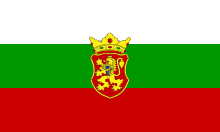Bulgarians in Serbia
Бугари у Србији Bugari u Srbiji Българи в Сърбия | |
|---|---|
 Flag of the National Council of the Bulgarian minority in Serbia | |
| Total population | |
| 12,918 Serbian citizens, 0.19% of Serbia's population (2022)[1] | |
| Regions with significant populations | |
| 4,075 (67.19%)[2] | |
| 3,669 (45.62%)[2] | |
| Languages | |
| Bulgarian, Serbian | |
| Religion | |
| Bulgarian Orthodox, Serbian Orthodox | |
| Related ethnic groups | |
| South Slavs | |
Bulgarians in Serbia (
national minority in Serbia. According to the 2022 census, the population of ethnic Bulgarians in Serbia is 12,918, constituting 0.2% of the total population. The vast majority of them live in the southeastern part of the country that borders Bulgaria and North Macedonia
.
History


| Part of a series on |
| Bulgarians Българи |
|---|
 |
| Culture |
| By country |
| Subgroups |
| Religion |
| Language |
| Other |
The regional names once used by many people in the Torlakian-speaking region was
A
Pirot Rebellion broke out in 1836, followed by the Niš rebellion in 1836, which also included Pirot. According to Ottoman statistics during the Tanzimat the greater part of the population up to the Sanjak of Niš was treated as Bulgarian.[6] According to all authors between 1840 and 1872 the delineation between Bulgarians and Serbs is undisputed and ran north of Niš.[7] The Serbian researchers (such as Dimitrije Davidović in 1828 and Milan Savić in 1878) also accepted South Morava river as such delineation and added Niš outside the borders of the Serbian people.[7][8] It was also stipulated the area to be ceded to Bulgaria according to the Constantinople Conference in 1876 and most of it according to the Treaty of San Stefano in 1878. From 1870 until then the area was part of the Bulgarian Orthodox Church, before that the area had been under the Ecumenical Patriarchate of Constantinople and the Serbian Patriarchate of Peć
.
Following
Internal Western Outland Revolutionary Organisation, countering Yugoslav rule in the region, was engaged in repeated attacks against the Yugoslav police and army. During World War II Bulgaria retook the Western Outlands, as well as Pirot and Vranje. After the Second World War, these regions were returned to Yugoslavia. After Serbia
's independence, these areas remained within Serbia.
Demographics
According to the 2011 census, there were 18,543 Bulgarians in Serbia. They are primarily located in two municipalities near Serbia's border with Bulgaria: in Bosilegrad there are 5,839 Bulgarians i.e. 71.9% of population while in Dimitrovgrad (Tsaribrod) there are 5,413 Bulgarians or 53.5% of population.[9][10]
The dominant religion among ethnic Bulgarians in Serbia is
Serbian and Bulgarian churches due to the low number of Bulgarian clergymen present in the region. There is a church in every village around Bosilegrad
, and the oldest ones date to the 11th century.
| Year (census data) |
Number of ethnic Bulgarians | Number of Bulgarian speakers | Percent of national population |
|---|---|---|---|
| 1948 | 59,472 | 1.0% | |
| 1953 | 60,146 | 59,166 | 1.0% |
| 1961 | 58,494 | 0.9% | |
| 1971 | 53,800 | 49,942 | 0.7% |
| 1981 | 33,455 | 35,269 | 0.4% |
| 1991 | 26,698 | 25,408 | 0.3% |
| 2002 | 20,497 | 16,459 | 0.3% |
| 2011 | 18,543 | 13,337 | 0.3% |
| 2022 | 12,918 | 7,939 | 0.2% |
Notable people
- Helena of Bulgaria, regent of Serbia 1355–1356
- Gregory Tsamblak (c.1365–1420), medieval writer and cleric
- Vene Bogoslavov (1932–2015), mathematician
References
- ^ "Final results - Ethnicity". Почетна. 2023-07-14. Retrieved 2023-12-07.
- ^ a b "Population by ethnicity, by areas" (PDF). Retrieved 2023-12-07.
- ISBN 0313319499.
- ^ Василев, В.П. Темският ръкопис – български езиков паметник от 1764 г, Paleobulgarica, IX (1986), кн. 1, с. 49-72
- ^ Kultur der Nationen (in German). p. 110.
- ^ Ottoman Bulgaria in the First Tanzimat Period — The Revolts in Nish (1841) and Vidin (1850) Mark Pinson, Middle Eastern Studies, Vol. 11, No 2 (May, 1975), pp. 103-146.
- ^ ISBN 9780847688104.
- ^ Savić, Milan (1981). "Istorii︠a︡ na bŭlgarskii︠a︡ narod". google.bg.
- ^ "Ethno-confessional and language mosaic of Serbia" (PDF). Statistical Office of the Republic of Serbia. 2014.
- ^ http://www.isac-fund.org/download/sr-bg-BUG.pdf.
{{cite web}}: Missing or empty|title=(help)

